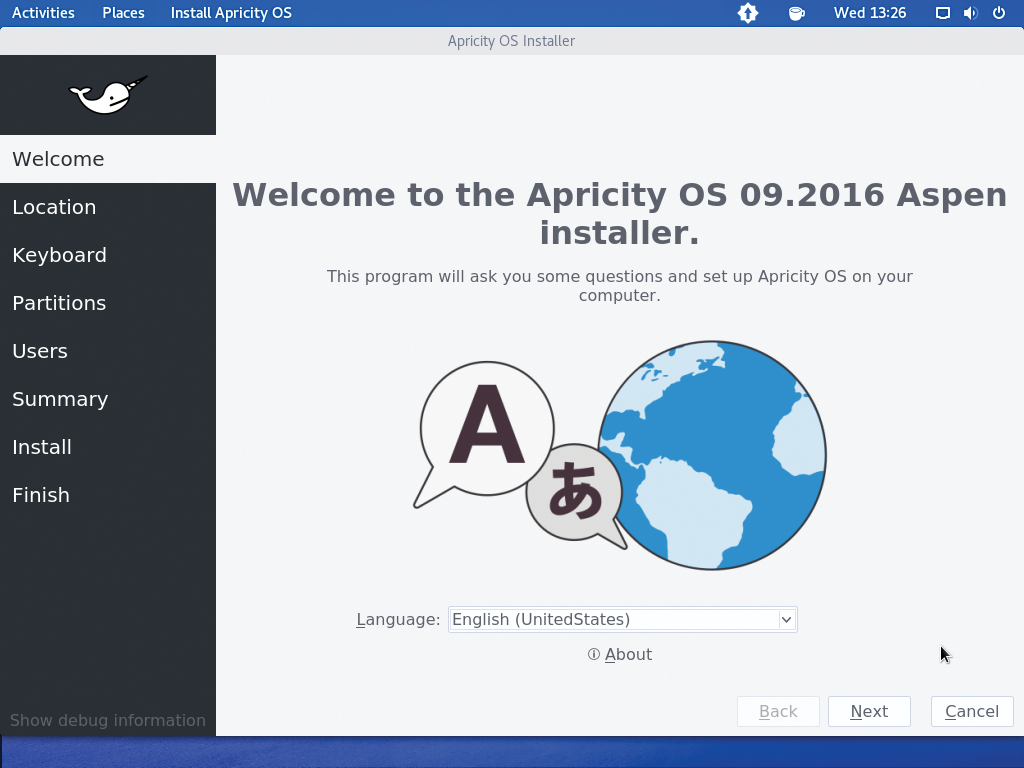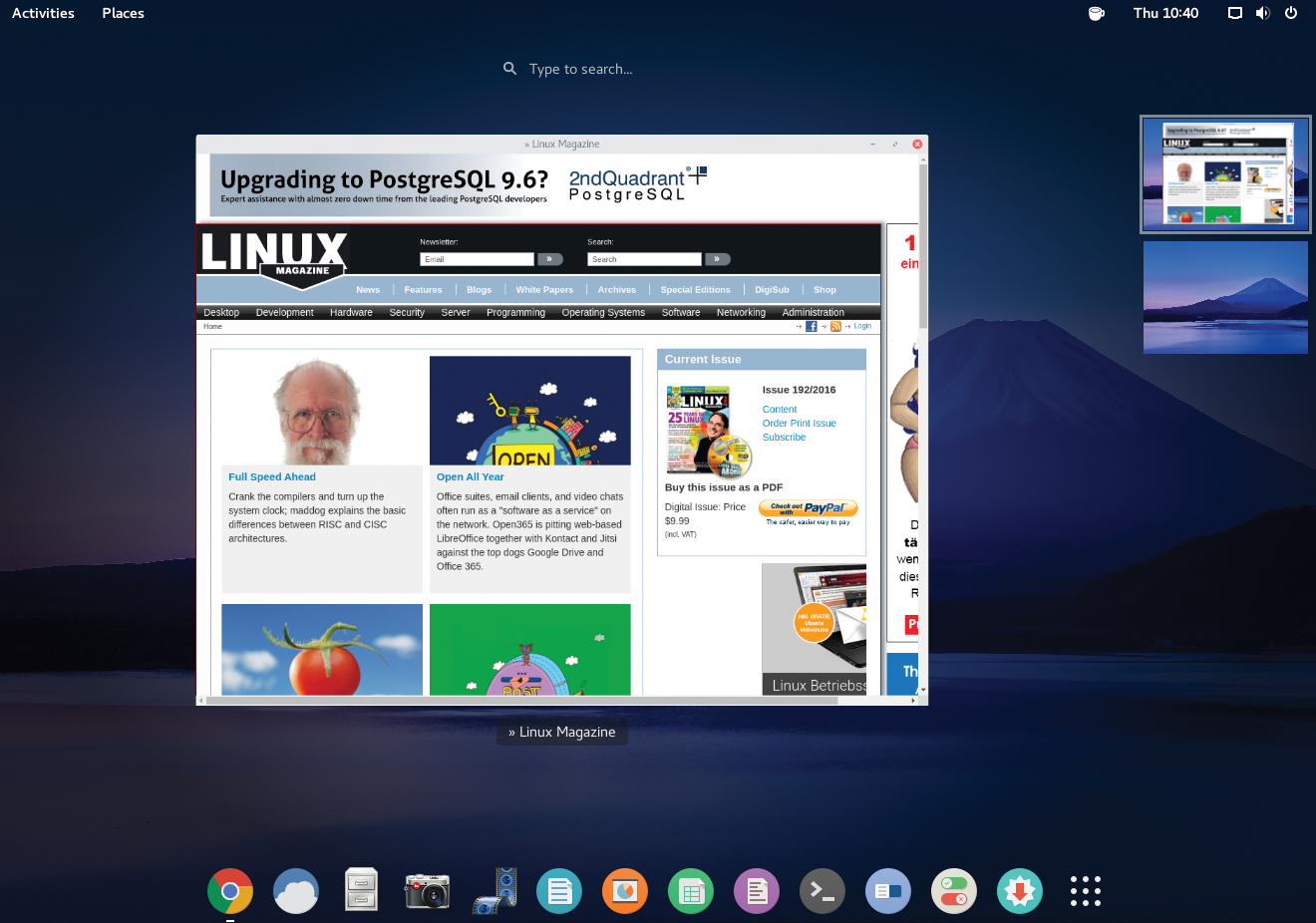
Arch Linux, packaged in style
Wolf in Sheep's Clothing
Apricity OS takes its name from an archaic term for the winter sun's warmth. However, the developers' approach does require some energy and sometimes feels like they are trying to square the circle. They are using Arch Linux, which was previously considered a distro for experts, as the basis for an operating system targeted at beginners and the generation of mobile online workers and cloud users. Its focus is also on a simple, modern style. The key objectives are therefore completely different from those of Arch Linux.
The first stable version of Apricity OS appeared in July 2016 after several beta versions, followed in September by Apricity OS 09.2016 [1] (code-named Aspen), which was used for this test. The project was based on Gnome only in its beta phase, although another GTK desktop, Cinnamon, was added at the start of the year. Both desktop variants [2] weigh in at just under 2GB.
Although other distributions are considering no longer publishing 32-bit images, Apricity's developers are doing the opposite and offering an image of that type, although they characterized it as experimental at this time. This step does not appear entirely plausible, and unfortunately, the developers did not answer a question to this effect in time for this article.
Elegant Looks
First up in the test was the 64-bit image as a Live medium with Gnome desktop. The desktop is elegant and well-arranged. The design creates a consistent look, in conjunction with the Numix Icon Theme [3] and well-considered fonts. You can hardly tell at a glance that this desktop is based on Gnome.
As long as you do not consult the list of sources, the Arch foundation does not shine through. The desktop's appearance is more reminiscent of Mac OS or a tidied-up Chrome OS, which the system emulates in terms of its intention. When it comes to design, it is clear that Apricity is one of the brightest stars in the present distro constellation, not only for the Gnome version but, to a lesser extent, for the Cinnamon version.
Only Under the Hood
As you would expect, the text-based installer of Arch Linux is not there to greet you when trying to install the system. Instead, the installer framework Calamares (Figure 1) is used in the current version 2.4.1, querying the necessary information and moving the image to the hard disk in approximately five minutes.

Even beginners will encounter no unsolvable problems using the installer. The Gnome edition needs approximately 6.6GB of disk space, whereas the Cinnamon variant gets by with a little less. The developers promise that the system will be able to be used in the basic configuration immediately after installation.
After starting, Apricity occupied a moderate 535MB of RAM, which allows a minimum of 2GB as a reasonable default. By way of comparison, Fedora 24 takes around 750MB of RAM at startup in the Gnome variant. Thus, it's no wonder that the Apricity desktop is somewhat more agile when you use it.
The current edition from September provides the latest core 4.7.4-1 and the system management Systemd 231-1 init system, which is no less up to date. Apricity offers the LibreOffice suite and Google Chrome browser preinstalled for office work.
Both Gimp and Inkscape are available for image editing, and Rhythmbox and Totem cover the field of music and video. You can add games to the system with the already prepared Steam client and install many Windows applications easily with premade formulas using PlayOnLinux.
Well Equipped
You can start applications used often from entries in the dock on the bottom area of the screen (Figure 2). It only becomes clear that Gnome is behind the desktop in version 3.20 when you click on the grid icon on the far right; then, the overview of applications recognizable as Gnome appears (Figure 3).


If you rummage through the preinstalled software available there, all sections appear properly stocked, ranging from the applications already mentioned to the FTP client FileZilla to the BitTorrent client to Simple Backup to development tools for the Qt toolkit.
Developers have TLP tools [4] for notebooks to prolong battery life. You can keep encrypted data across multiple devices in sync without a cloud connection using Syncthing [5]. The program is available for Linux, Mac OS, Windows, and Android, so it manages to cover a broad spectrum of current operating systems.
The Uncomplicated Firewall (UFW) from Ubuntu, based on the package filter iptables, is also just a mouse click away, together with a graphical front end (Figure 4).

Arch and AUR
The entire repository of Arch Linux – including the Arch User Repository (AUR) – is available. You can unlock the latter in software management if needed. The graphical front end Pamac lets you run updates for the entire system and install individual packages (Figure 5); in a terminal, you can use Pacman [6], as is typical for Arch users.

Besides the branches Core, Extra, Community, and Multilib, you will see an additional repository called Apricity-Core, where you can find the distribution-specific packages. The distribution, like Arch Linux, follows the rolling release principle: Once installed, you can update the system consistently without reinstalling.
Back to Basics
A special feature for Internet workers and frequent web surfers is found in the dock behind the second icon from the left, which reveals the name Ice on mouseover. This site-specific browser (SSB) [7] allows you to start frequently used sites on the web as a separate browser instance using icons from the dock or the desktop (Figure 6).

This approach is particularly suitable for email and cloud applications like Nextcloud or Dropbox, as well as Google Plus, Facebook, Twitter, and similar services. Ice works with Google Chrome, Chromium, and Firefox.
When creating an entry, assign a name to the instance, define the associated URL, and select a section of the menu where you want to place the application. You can either select an icon yourself or use the site's favicon, which you put in the dock or on the desktop from the menu for quick access.
The distribution provides another special feature: its own build system, Freezedry [8], which allows you to create and download individual system configurations on the Apricity website with simply structured TOML configuration files [9] that may include other desktop environments and themes, along with a different selection of packages. If you want, you can pass on your individual composition to others for download [10].
Conclusion
Apricity OS is more than just a simple distribution with a good-looking design: It is also ideally suited for beginners, and even experienced users will find it pleasant to use, although it strays far from the paths beaten by the ubiquitous Ubuntu derivatives.
The distro, which excels in its visual arrangement, did not show any weaknesses in the test in terms of its functionality, even under intensive use – not a result you see too often. The developers have done an exemplary job with the balancing act between Arch Linux as a geeks' distro and a system consistently appropriate for entry-level users. The successful repertoire of packages covers all the important areas of use for a desktop computer, and Apricity's further aim is to provide an environment for productive work on the web and in the cloud.
It makes sense for Apricity to be restricted to the Gnome and Cinnamon desktops. As you can tell from the adjustments made, the developers are intimately familiar with the GTK foundation; this contributes significantly to the rounded appearance. The project retains some of the specific advantages of Gnome, such as the choice to work by mouse or touch and the successful adaptation to high-resolution HDPI displays.
